Mulching flower beds is often not viewed as the most fun way to spend a Saturday. However, adding mulch is beneficial to the plants in your yard. It also helps to complete the look of your landscape. Mulching puts the finishing touches on your flower beds and garden areas.
Mulching Flower Beds
Types of Mulch in Flower Beds
First, let’s talk about the best type of mulch to use in your landscape beds and flower gardens. The most beneficial mulch to use in your flower gardens is a natural mulch from trees or plant material. The types of natural mulch that are available will vary based on your location. Some examples of natural mulch are hardwood mulch, hemlock mulch, and pine mulch. 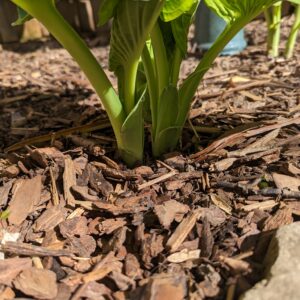
Natural mulch can be purchased from garden and home stores in bags. Buying in bags can be beneficial if you have a small area to mulch or don’t have a way to transfer bulk quantities of mulch. Buying bulk mulch by the yard is a more economically friendly option. However, delivery, or picking up by truck or trailer is necessary.
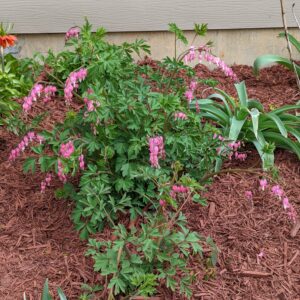
Red Colored Mulch in Landscape Bed
You may be wondering if the decorative colored mulch is good for flower beds. While it’s not bad for flower beds it doesn’t have the same nutrients as natural mulch does when it breaks down. Therefore, it will not be as beneficial to the plants as natural mulch. It will help to cool the roots, retain moisture and prevent weeds.
Using Decorative Stone in Flower Beds
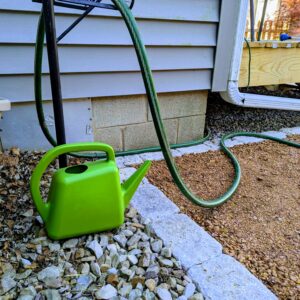
Decorative stone near water station including hose reel, hose, and watering can.
Decorative stone has its place in the landscape, however, there are drawbacks to using decorative stone in garden areas. Natural stone heats up the soil, therefore, using natural stone in flower beds will increase the amount of water needed. It does not break down over time like natural mulch, therefore, it does not add nutrients to the soil. However, if there is an area in your yard you don’t want to have plants in. For example against part of the house or garage that is unseen, decorative stone can be beneficial. If decorative stone is the desired look for the landscape, keep in mind that drought and heat-tolerant plants will do best in these areas.
When to add Mulch to Flower Gardens
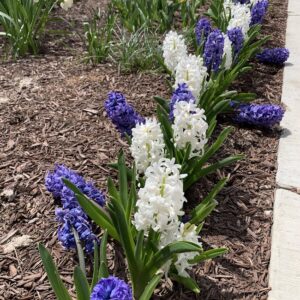
Mulch in spring flower bulb planting area
The ideal time to apply mulch is in early to mid-spring when cleaning up the garden. However, life gets busy and sometimes mulching your flower beds can’t happen until summer. That is ok too. There really is no time that you could say it’s too late in the season to add mulch if you haven’t done so already. By adding mulch early in the growing season you will get the most benefit of the mulch for your plants.
Adding mulch in the fall is an option too. If you have newly planted flower bulbs adding mulch to the area will help to insulate and protect them. Beds that had mulch added in the fall may need a spruce up in spring by adding a very light layer of mulch.
How Much Mulch to Apply
New garden and landscape beds should apply 2-3″ of fresh mulch. If you have mulch from previous seasons and want to freshen up the planting beds, 1-2″ of mulch will be adequate.
Adding Mulch to Flower Bulb Plantings
It is a good idea to add mulch to the areas where flower bulbs were planted. This helps to regulate the temperature and soil moisture levels, which are important to healthy flower bulbs.
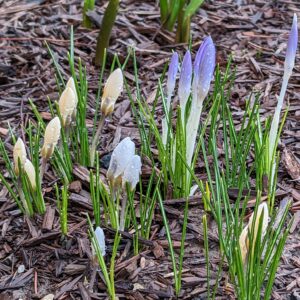 Bulbs grow through the mulch as they emerge. However, the addition of mulch should be factored into the planting depth. Therefore, if new mulch 2-3″ is planted and the bulbs are suggested to be planted at a 6-8″ depth, plant the bulbs 4-6″ beneath the soil surface to account for the mulch they will need to emerge through.
Bulbs grow through the mulch as they emerge. However, the addition of mulch should be factored into the planting depth. Therefore, if new mulch 2-3″ is planted and the bulbs are suggested to be planted at a 6-8″ depth, plant the bulbs 4-6″ beneath the soil surface to account for the mulch they will need to emerge through.
If your bulbs are already planted and they were planted well before mulch was added, there is no need to re-plant or adjust. They will still be able to emerge through the mulch if they were planted at the suggested depth that did not take mulch into consideration.
Adding Mulch to Perennials, Trees, and Shrubs
When adding mulch to established landscape areas that have perennials, trees, and shrubs there are some things you can do to make it easier.
When mulching around trees and shrubs be sure that the mulch is not encroaching up the trunk. This is known by landscape industry experts as a mulch volcano. Pull the mulch back a few inches from the trunk to allow for airspace. Mulch that is smothering the trunk can lead to rotting issues. 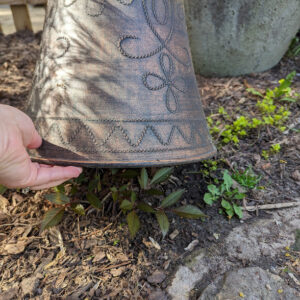
A tip for adding mulch to perennials, and bulbs that have emerged is to cover them with pots prior to adding mulch. This allows you to dump the mulch and spread it without burying the plants or covering the leaves. When you are done adding mulch remove the pots. Spread out any mulch that needs to be cleaned up. Leave space near the base of the plant, so it is not being smothered and covered with mulch.
Using Weed Fabric in the Landscape
There are times and places when applying weed fabric in the landscape is beneficial. When using decorative stone in the garden weed fabric should be applied prior to placing the stone in the landscape. This will help prevent weeds which can be difficult to remove from garden areas with stone in them.
Weed fabric can be a barrier to some weeds growing in the garden, however, it won’t block weeds from emerging 100%. Some weeds arrive from the wind or birds dropping seeds in the garden, weed fabric won’t prevent those weeds from emerging.
If you are adding a new planting area and want to put weed fabric down it should be done before mulch is added. Bulbs and perennials won’t be able to emerge through the weed fabric. Therefore, when applying weed fabric and planting, cut holes in the weed fabric where you are planting. This will allow the perennials, bulbs, or shrubs to grow around the weed fabric as there is space made for them to be able to emerge.
Don’t Forget to Mulch
The benefits of natural mulch for your plants are numerous. They help to add organic matter as the mulch breaks down. It helps to cool the roots, which leads to happier plants. Mulch helps to regulate the soil moisture level, which can mean less water is required. Mulch really is the icing on the cake, it completes the landscape and helps to define garden beds. Be sure to cover the soil with mulch it’s good for the plants, and therefore, good for the earth!


